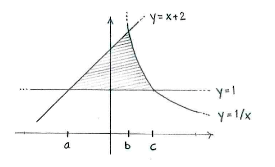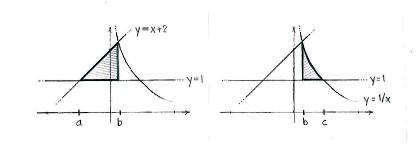Lösung 2.1:4d
Aus Online Mathematik Brückenkurs 2
K |
|||
| (Der Versionsvergleich bezieht 6 dazwischen liegende Versionen mit ein.) | |||
| Zeile 1: | Zeile 1: | ||
| - | + | Wir zeichnen die Kurven. | |
[[Image:2_1_4_d1.gif|center]] | [[Image:2_1_4_d1.gif|center]] | ||
| - | + | Zeichnen wir alle Kurven im selben Bild, sehen wir, dass die Fläche unten von der Geraden <math>y=1</math> begrenzt ist und oben von den Kurven <math>y=x+2</math> und <math>y=1/x\,</math>. | |
[[Image:2_1_4_d2.gif|center]] | [[Image:2_1_4_d2.gif|center]] | ||
| - | + | Wir benennen die drei Schnittstellen der Kurven <math>x=a</math>, <math>x=b</math> und <math>x=c</math>, wie in der Figur gezeigt. Wir sehen so, dass die Fläche in zwei Teilflächen eingeteilt werden kann. Eine zwischen <math>x=a</math> und <math>x=b</math>, wo die obere Grenze <math>y=x+2</math> ist und eine zwischen <math>x=b</math> und <math>x=c</math> wo <math>y=1/x</math> die obere Grenze ist. | |
[[Image:2_1_4_d3.gif|center]] | [[Image:2_1_4_d3.gif|center]] | ||
| - | + | Die Flächen dieser Gebiete sind | |
| - | {{ | + | {{Abgesetzte Formel||<math>\begin{align} |
| - | \text{ | + | \text{Linke Fläche} &= \int\limits_a^b (x+2-1)\,dx\,\\[5pt] |
| - | \text{ | + | \text{Rechte Fläche} &= \int\limits_b^c \Bigl(\frac{1}{x}-1\Bigr)\,dx\, |
\end{align}</math>}} | \end{align}</math>}} | ||
| - | + | Die gesamte Fläche ist die Summe der beiden Flächen. | |
| - | + | Wir suchen also die Schnittstellen: | |
| - | + | *<math>x=a</math>: Die Schnittstelle von <math>y=1</math> und <math>y=x+2</math> erfüllt beide Gleichungen: | |
| - | + | {{Abgesetzte Formel||<math>\left\{\begin{align} | |
| - | *<math>x=a</math>: | + | |
| - | + | ||
| - | {{ | + | |
y &= 1\,,\\[5pt] | y &= 1\,,\\[5pt] | ||
y &= x+2\,\textrm{.} | y &= x+2\,\textrm{.} | ||
\end{align}\right.</math>}} | \end{align}\right.</math>}} | ||
| - | : | + | :Dies ergibt <math>x+2=1</math>, also <math>x=-1\,</math>. Daher ist <math>a=-1\,</math>. |
| - | *<math>x=b</math>: | + | *<math>x=b</math>: Die Schnittstelle von <math>y=x+2</math> und <math>y=1/x</math> erfüllt beide Gleichungen: |
| - | {{ | + | {{Abgesetzte Formel||<math>\left\{\begin{align} |
y &= x+2\,,\\[5pt] | y &= x+2\,,\\[5pt] | ||
y &= 1/x\,\textrm{.} | y &= 1/x\,\textrm{.} | ||
\end{align}\right.</math>}} | \end{align}\right.</math>}} | ||
| - | : | + | :Eliminieren wir <math>y</math> erhalten wir für <math>x</math> diese Gleichung |
| - | {{ | + | {{Abgesetzte Formel||<math>x+2=\frac{1}{x}\,,</math>}} |
| - | : | + | :die wir mit <math>x</math> multiplizieren, |
| - | {{ | + | {{Abgesetzte Formel||<math>x^{2}+2x=1\,\textrm{.}</math>}} |
| - | : | + | :Quadratische Ergänzung ergibt: |
| - | {{ | + | {{Abgesetzte Formel||<math>\begin{align} |
| - | (x+1)^2 - 1^2 &= 1\ | + | (x+1)^2 - 1^2 &= 1\,\\[5pt] |
| - | (x+1)^2 &= 2\, | + | (x+1)^2 &= 2\,. |
\end{align}</math>}} | \end{align}</math>}} | ||
| - | : | + | :Die Wurzeln sind daher <math>x=-1\pm \sqrt{2}</math> und dies ergibt |
| - | <math>b=-1+\sqrt{2}</math>. ( | + | <math>b=-1+\sqrt{2}</math>. (Die Lösung <math>b=-1-\sqrt{2}</math> |
| - | + | liegt links von <math>x=a\,</math>.) | |
| - | *<math>x=c</math>: | + | *<math>x=c</math>: Dies ist die Schnittstelle von <math>y=1</math> und <math>y=1/x\,</math>, also ist <math>x=1\,</math>, daher <math>c=1\,</math>. |
| - | + | Die Teilflächen sind also | |
| - | {{ | + | {{Abgesetzte Formel||<math>\begin{align} |
| - | \text{ | + | \text{Linke Fläche} |
&= \int\limits_{-1}^{\sqrt{2}-1} (x+2-1)\,dx\\[5pt] | &= \int\limits_{-1}^{\sqrt{2}-1} (x+2-1)\,dx\\[5pt] | ||
&= \int\limits_{-1}^{\sqrt{2}-1} (x+1)\,dx\\[5pt] | &= \int\limits_{-1}^{\sqrt{2}-1} (x+1)\,dx\\[5pt] | ||
| Zeile 75: | Zeile 72: | ||
&= \frac{2-2\sqrt{2}+1}{2} + \sqrt{2} - 1 - \frac{1}{2} + 1\\[5pt] | &= \frac{2-2\sqrt{2}+1}{2} + \sqrt{2} - 1 - \frac{1}{2} + 1\\[5pt] | ||
&= 1 - \sqrt{2} + \frac{1}{2} + \sqrt{2} - 1 - \frac{1}{2} + 1\\[5pt] | &= 1 - \sqrt{2} + \frac{1}{2} + \sqrt{2} - 1 - \frac{1}{2} + 1\\[5pt] | ||
| - | &= 1\ | + | &= 1\,\textrm{.}\\[10pt] |
| - | \text{ | + | \text{Rechte Fläche} |
&= \int\limits_{\sqrt{2}-1}^1 \Bigl(\frac{1}{x}-1\Bigr)\,dx\\[5pt] | &= \int\limits_{\sqrt{2}-1}^1 \Bigl(\frac{1}{x}-1\Bigr)\,dx\\[5pt] | ||
&= \Bigl[\ \ln |x| - x\ \Bigr]_{\sqrt{2}-1}^1\\[5pt] | &= \Bigl[\ \ln |x| - x\ \Bigr]_{\sqrt{2}-1}^1\\[5pt] | ||
| Zeile 84: | Zeile 81: | ||
\end{align}</math>}} | \end{align}</math>}} | ||
| - | + | Die gesamte Fläche ist | |
| - | {{ | + | {{Abgesetzte Formel||<math>\begin{align} |
| - | \text{ | + | \text{Fläche} |
| - | &= \text{( | + | &= \text{(Linke Fläche)} + \text{(Rechte Fläche)}\\[5pt] |
&= 1 + \sqrt{2} - 2 - \ln\bigl(\sqrt{2}-1\bigr)\\[5pt] | &= 1 + \sqrt{2} - 2 - \ln\bigl(\sqrt{2}-1\bigr)\\[5pt] | ||
&= \sqrt{2} - 1 - \ln\bigl(\sqrt{2}-1\bigr)\,\textrm{.} | &= \sqrt{2} - 1 - \ln\bigl(\sqrt{2}-1\bigr)\,\textrm{.} | ||
\end{align}</math>}} | \end{align}</math>}} | ||
Aktuelle Version
Wir zeichnen die Kurven.
Zeichnen wir alle Kurven im selben Bild, sehen wir, dass die Fläche unten von der Geraden \displaystyle y=1 begrenzt ist und oben von den Kurven \displaystyle y=x+2 und \displaystyle y=1/x\,.
Wir benennen die drei Schnittstellen der Kurven \displaystyle x=a, \displaystyle x=b und \displaystyle x=c, wie in der Figur gezeigt. Wir sehen so, dass die Fläche in zwei Teilflächen eingeteilt werden kann. Eine zwischen \displaystyle x=a und \displaystyle x=b, wo die obere Grenze \displaystyle y=x+2 ist und eine zwischen \displaystyle x=b und \displaystyle x=c wo \displaystyle y=1/x die obere Grenze ist.
Die Flächen dieser Gebiete sind
| \displaystyle \begin{align}
\text{Linke Fläche} &= \int\limits_a^b (x+2-1)\,dx\,\\[5pt] \text{Rechte Fläche} &= \int\limits_b^c \Bigl(\frac{1}{x}-1\Bigr)\,dx\, \end{align} |
Die gesamte Fläche ist die Summe der beiden Flächen.
Wir suchen also die Schnittstellen:
- \displaystyle x=a: Die Schnittstelle von \displaystyle y=1 und \displaystyle y=x+2 erfüllt beide Gleichungen:
| \displaystyle \left\{\begin{align}
y &= 1\,,\\[5pt] y &= x+2\,\textrm{.} \end{align}\right. |
- Dies ergibt \displaystyle x+2=1, also \displaystyle x=-1\,. Daher ist \displaystyle a=-1\,.
- \displaystyle x=b: Die Schnittstelle von \displaystyle y=x+2 und \displaystyle y=1/x erfüllt beide Gleichungen:
| \displaystyle \left\{\begin{align}
y &= x+2\,,\\[5pt] y &= 1/x\,\textrm{.} \end{align}\right. |
- Eliminieren wir \displaystyle y erhalten wir für \displaystyle x diese Gleichung
| \displaystyle x+2=\frac{1}{x}\,, |
- die wir mit \displaystyle x multiplizieren,
| \displaystyle x^{2}+2x=1\,\textrm{.} |
- Quadratische Ergänzung ergibt:
| \displaystyle \begin{align}
(x+1)^2 - 1^2 &= 1\,\\[5pt] (x+1)^2 &= 2\,. \end{align} |
- Die Wurzeln sind daher \displaystyle x=-1\pm \sqrt{2} und dies ergibt
\displaystyle b=-1+\sqrt{2}. (Die Lösung \displaystyle b=-1-\sqrt{2} liegt links von \displaystyle x=a\,.)
- \displaystyle x=c: Dies ist die Schnittstelle von \displaystyle y=1 und \displaystyle y=1/x\,, also ist \displaystyle x=1\,, daher \displaystyle c=1\,.
Die Teilflächen sind also
| \displaystyle \begin{align}
\text{Linke Fläche} &= \int\limits_{-1}^{\sqrt{2}-1} (x+2-1)\,dx\\[5pt] &= \int\limits_{-1}^{\sqrt{2}-1} (x+1)\,dx\\[5pt] &= \Bigl[\ \frac{x^2}{2} + x\ \Bigr]_{-1}^{\sqrt{2}-1}\\[5pt] &= \frac{\bigl(\sqrt{2}-1\bigr)^2}{2} + \sqrt{2} - 1 - \Bigl(\frac{(-1)^2}{2} + (-1) \Bigr)\\[5pt] &= \frac{\bigl(\sqrt{2}\bigr)^2-2\sqrt{2}+1}{2} + \sqrt{2} - 1 - \frac{1}{2} + 1\\[5pt] &= \frac{2-2\sqrt{2}+1}{2} + \sqrt{2} - 1 - \frac{1}{2} + 1\\[5pt] &= 1 - \sqrt{2} + \frac{1}{2} + \sqrt{2} - 1 - \frac{1}{2} + 1\\[5pt] &= 1\,\textrm{.}\\[10pt] \text{Rechte Fläche} &= \int\limits_{\sqrt{2}-1}^1 \Bigl(\frac{1}{x}-1\Bigr)\,dx\\[5pt] &= \Bigl[\ \ln |x| - x\ \Bigr]_{\sqrt{2}-1}^1\\[5pt] &= \ln 1 - 1 - \Bigl( \ln \bigl(\sqrt{2}-1\bigr)-\bigl(\sqrt{2}-1\bigr)\Bigr)\\[5pt] &= 0 - 1 - \ln \bigl(\sqrt{2}-1\bigr) + \sqrt{2} - 1\\[5pt] &= \sqrt{2} - 2 - \ln\bigl(\sqrt{2}-1\bigr)\,\textrm{.} \end{align} |
Die gesamte Fläche ist
| \displaystyle \begin{align}
\text{Fläche} &= \text{(Linke Fläche)} + \text{(Rechte Fläche)}\\[5pt] &= 1 + \sqrt{2} - 2 - \ln\bigl(\sqrt{2}-1\bigr)\\[5pt] &= \sqrt{2} - 1 - \ln\bigl(\sqrt{2}-1\bigr)\,\textrm{.} \end{align} |



